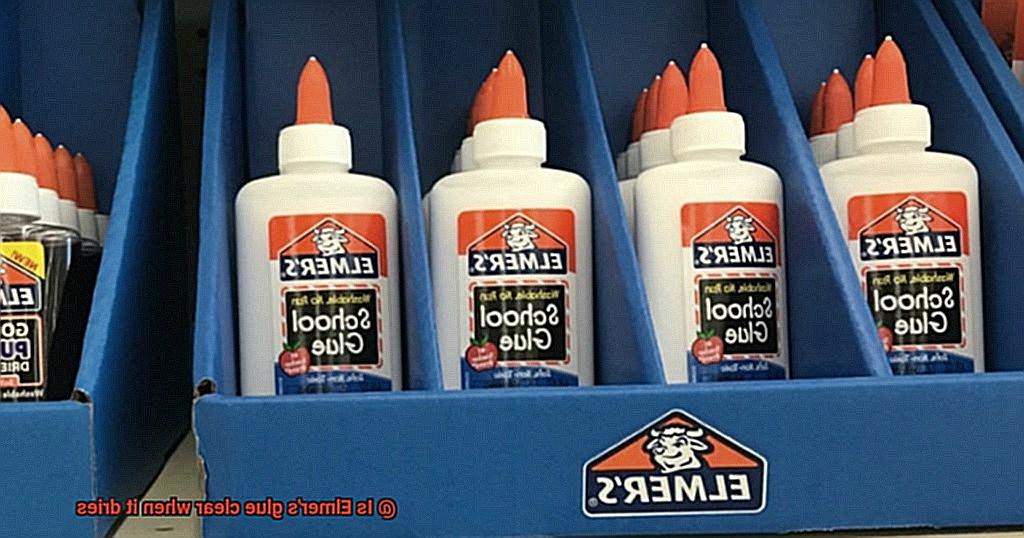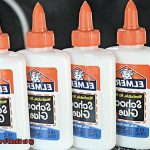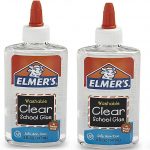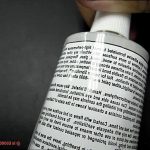In the vast and vibrant world of arts and crafts, one adhesive reigns supreme: Elmer’s Glue. Crafters and DIY enthusiasts alike have long relied on this iconic glue for their creative projects. But there’s one burning question that lingers in the minds of artisans everywhere: does Elmer’s Glue really dry clear? The answer to this seemingly simple inquiry is far from black and white.
Surprisingly, despite its liquid form being unmistakably white, Elmer’s Glue undergoes a mesmerizing transformation as it dries. This leaves us wondering if it maintains its transparent allure or if it takes on a different shade altogether. Whether you’re an experienced artist or a novice crafter, understanding how Elmer’s Glue visually impacts your projects is key to achieving the desired outcome.
So join us on an enlightening journey as we unravel the mysteries surrounding Elmer’s Glue and its claim to drying clear. In this blog post, we’ll delve into the science behind this phenomenon, gather insights from seasoned users, and provide you with tips and tricks to ensure your projects boast that coveted transparent finish.
Whether you’re working on collages, paper crafts, or any other creative endeavor, consider this article your ultimate guide to demystifying the truth behind Elmer’s Glue and its ability to dry clear. Get ready to enhance your artistic pursuits with newfound knowledge gained through this exploration.
What is Elmer’s Glue?
Contents
- 1 What is Elmer’s Glue?
- 2 Does Elmer’s Glue Dry Clear?
- 3 What Factors Affect the Drying Time of Elmer’s Glue?
- 4 Does Elmer’s Glue Leave a Sheen or Gloss on Certain Surfaces?
- 5 Versatility and Bond Strength of Elmer’s Glue
- 6 Is Elmer’s Glue Safe for Children to Use?
- 7 Removing Elmer’s Glue Before it Dries
- 8 Common Uses for Elmer’s Glue
- 9 Conclusion
Elmer’s glue, a name that brings back memories of childhood crafts and endless possibilities. But what exactly is Elmer’s glue, and why has it remained a beloved adhesive for generations? In this comprehensive exploration, we will delve into the world of Elmer’s glue, uncovering its adhesive marvels, diverse product offerings, and practical applications that have made it a household staple.
The Adhesive Marvel:
At the heart of Elmer’s glue lies its secret weapon – polyvinyl acetate (PVA), a synthetic polymer renowned for its exceptional bonding capabilities. This versatile adhesive possesses the power to unite an array of materials, seamlessly bonding paper, fabric, wood, and even certain plastics.
Its remarkable strength ensures that repairs stand the test of time while igniting artistic endeavors with limitless possibilities.
Types of Elmer’s Glue:
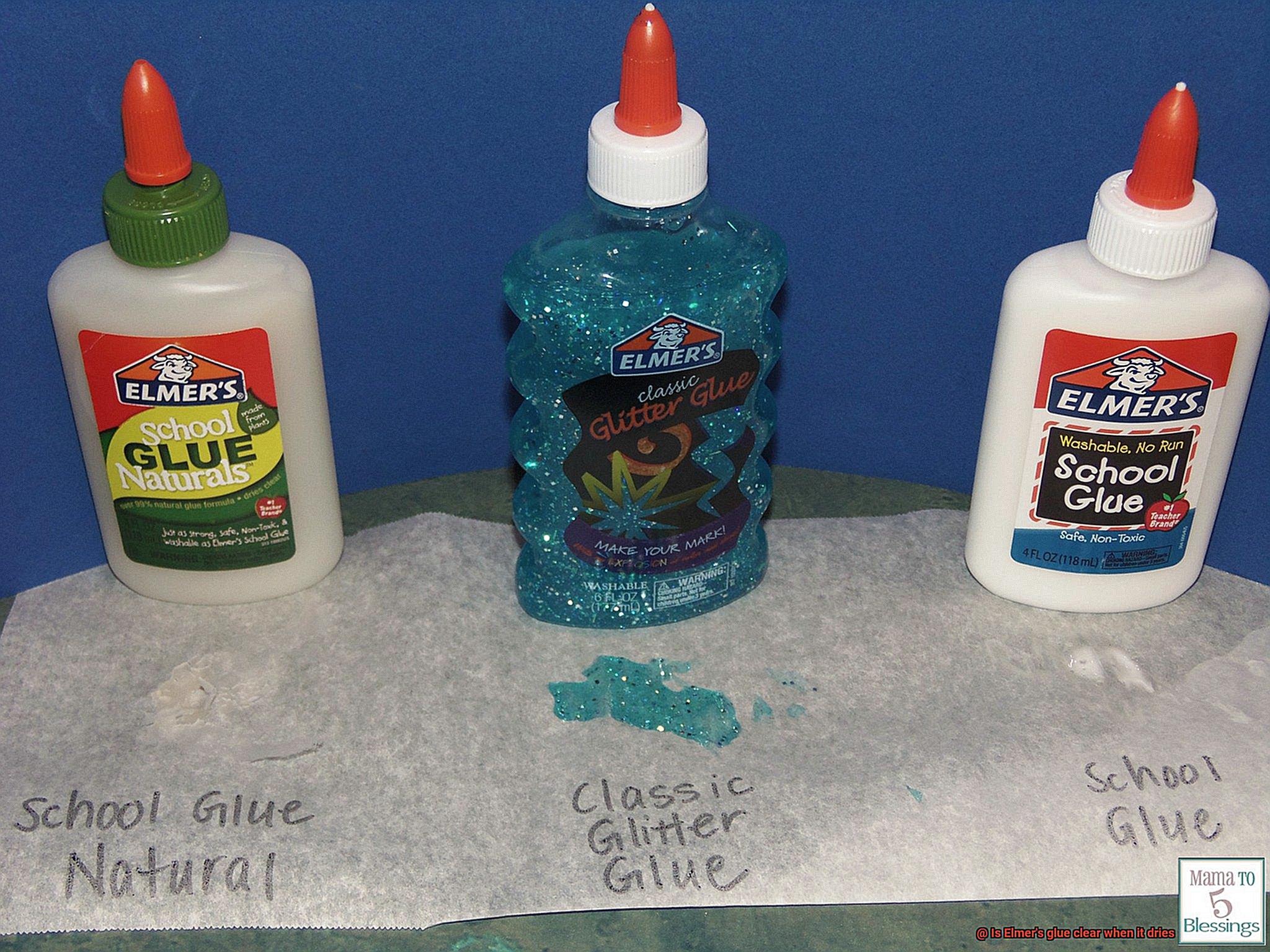
Elmer’s Glue presents a dazzling variety of formulations tailored to specific needs. The classic white glue boasts a milky appearance when wet but dries to an invisible finish, making it ideal for projects where the adhesive should remain unseen or blend seamlessly with the materials at hand. Its counterpart, clear glue, maintains its transparency both in wet and dry states, ensuring the adhesive itself remains hidden from view.
Specialized Formulations:
Elmer’s Glue has expanded its repertoire to cater to diverse creative pursuits. Enter glitter glue, a shimmering delight adorned with tiny metallic particles that adds an enchanting sparkle to arts and crafts projects. For those who crave the extraordinary, glow-in-the-dark glue brings creations to life under UV light or in dimly lit environments, captivating both children and adults alike. And for the little Picasso in your life, washable glue offers peace of mind with its easy removal from fabrics and surfaces.
Ease of Use and Safety:
One of Elmer’s glue’s enduring charms lies in its simplicity. As a water-based adhesive, it effortlessly washes away with soap and water, leaving no trace of spills or excess adhesive. Its non-toxic nature ensures the safety of both young and old as they embark on their creative journeys.
Does Elmer’s Glue Dry Clear?
Elmer’s glue is a beloved adhesive in the crafting and DIY world, renowned for its reliability and versatility. One burning question that often arises is whether Elmer’s glue dries clear or leaves a visible residue. The answer, my friends, is a resounding yes. Elmer’s white glue and clear glue, the standard formulations, dry clear and become transparent once they are fully cured.
But why does Elmer’s glue have this remarkable property while other glues may not? Let’s delve into the captivating science behind it. When you apply Elmer’s white or clear glue to a surface, it may initially appear white or cloudy when wet. However, as the water content in the adhesive evaporates during the drying process, magic happens – the glue becomes transparent.
The transparency of dried Elmer’s glue makes it incredibly versatile for a wide range of applications. Whether you’re engaged in paper crafts, collage projects, or general household repairs, you can trust that your bond will be invisible once the glue has dried completely. And fear not about its durability – Elmer’s glue offers robust adhesion once it has fully cured, ensuring your projects or repairs stand the test of time.
It’s important to note that while Elmer’s white glue and clear glue dry clear, other specialty formulations like glitter glue or colored glues may retain some visible color or shimmer after drying. These types of glues are designed explicitly to add decorative elements to your projects and may not dry completely transparent.
So, if you’re reaching for that trusty bottle of Elmer’s white or clear glue for your next crafting adventure, rest assured that you’ll achieve a clear and durable bond once the adhesive has dried completely. But if you’re looking to add some pizzazz with glitter or color, be mindful that those glues may leave behind a bit of sparkle or hue.
What Factors Affect the Drying Time of Elmer’s Glue?
Today, we’ll dive into the fascinating world of Elmer’s glue and explore the myriad factors that affect its drying time. Timing is everything in crafting, so understanding these factors can make a world of difference in your projects.
Let’s begin by examining the different types of Elmer’s glue. From their classic white glue to the clear and school glue, each type may have different formulations that impact drying time. Clear glue, with its thinner consistency, tends to dry faster than white glue. So, when selecting your adhesive superhero, keep this in mind.
Now, let’s talk about the environmental conditions. Temperature and humidity play a significant role in the drying time of Elmer’s glue. Higher temperatures and lower humidity levels speed up the drying process, while lower temperatures and higher humidity slow it down. Imagine working in a chilly basement or a humid environment – be prepared for a longer drying time.
The thickness or amount of glue applied is another crucial factor. Thicker layers take longer to dry compared to thin, even coatings. So, remember to apply a thin layer for quicker results – less is more.
Consider the surface material you’re working with as well. Porous surfaces like paper or wood tend to absorb moisture from the glue, potentially slowing down drying time. On the other hand, non-porous surfaces like plastic or glass allow the glue to dry faster since there is no absorption. Think of it as a dance between the glue and the surface.
Proper ventilation and air circulation are essential for faster drying. Adequate airflow helps evaporate the water content in the glue more efficiently. Imagine a gentle breeze guiding your project towards completion. Consider working in a well-ventilated area or using fans to speed up the process.
If you’re feeling adventurous and decide to add any additives to your Elmer’s glue, be aware that they can affect drying time too. Certain additives like baking soda or borax may alter the glue’s properties and impact how long it takes to dry. It’s like adding a twist to the recipe – just be mindful of how it affects your project’s drying time.
Lastly, keep in mind the glue-to-water ratio. Diluting Elmer’s glue with water is a common technique, but be aware that adding more water can extend drying time. It’s like adjusting the balance in a delicate equation – find the right proportions for your desired outcome.
Does Elmer’s Glue Leave a Sheen or Gloss on Certain Surfaces?
Does Elmer’s glue leave a sheen or gloss on certain surfaces? In this in-depth exploration, we will delve into the intricacies of Elmer’s glue and its effects on both porous and non-porous surfaces. Whether you’re embarking on a paper craft or tackling a glass project, get ready to uncover the mysteries behind Elmer’s glue and how it influences the final appearance of your masterpiece.
Porous Surfaces:
When it comes to porous surfaces like paper, cardboard, or fabric, Elmer’s glue works its magic by drying with a beautifully matte finish. It seamlessly absorbs into the material, creating a strong bond without leaving behind any noticeable sheen or gloss. This makes it the perfect adhesive for scrapbooking, paper crafts, and fabric embellishments where you want the glue to blend effortlessly into the background.
Non-Porous Surfaces:
On non-porous surfaces such as glass, plastic, or metal, Elmer’s glue may leave a slight sheen once it dries. These materials are less absorbent, resulting in a different interaction between the glue and surface. However, fear not. The sheen left by Elmer’s glue on non-porous surfaces is usually subtle and nowhere near as noticeable as when using glossy finishes specifically designed for these materials.
Factors Affecting Finish:
The finish of Elmer’s glue can be influenced by various factors. One such factor is the application thickness. Applying the glue thinly and allowing it to dry undisturbed is more likely to result in a clear finish without any sheen. Conversely, applying the glue too thickly or exposing it to moisture or humidity during drying may lead to a slightly more visible sheen.
Layering the Glue:
Here’s a secret trick: layering Elmer’s glue can impact the finish. When layering the glue on porous surfaces, it might enhance the sheen ever so slightly. On non-porous surfaces, however, be prepared for a thicker and more noticeable sheen. If you prefer a completely matte finish, it’s best to apply a single layer of glue and resist the temptation to add more once it has dried.
Versatility and Bond Strength of Elmer’s Glue
Elmer’s glue is a true chameleon in the world of adhesives. It has the remarkable ability to bond to almost anything you can imagine. From the humble paper and cardboard to the delicate fabric and sturdy wood, Elmer’s glue has got you covered. It is the go-to adhesive for school projects, fabric crafts, and even repairing broken wooden chairs. There’s no challenge too big or too small for this versatile glue.
But what sets Elmer’s glue apart is its impressive bond strength. When applied correctly and allowed to dry completely, it forms a clear and strong bond that can withstand regular handling and use. Say goodbye to staples and tape when you need to stick two pieces of paper together. Elmer’s glue will hold those sheets securely in place.
However, it’s worth mentioning that the bond strength may vary depending on the materials being bonded. For lighter materials like paper or fabric, Elmer’s glue alone may be sufficient. But for heavier materials like wood or plastic, it’s always a good idea to use additional support or reinforcement for a long-lasting bond.
Another remarkable feature of Elmer’s glue is its flexibility. It creates bonds that have just the right amount of give, making it perfect for fabric crafts or bookbinding. Your creations won’t become stiff or brittle over time, ensuring they stay intact for years to come.
To use Elmer’s glue effectively, follow the manufacturer’s instructions for best results. Different types of Elmer’s glue may have different drying times and application methods. Additionally, test the bond strength on a small area before applying it to your entire project. This way, you can ensure compatibility with your materials and achieve the desired bond strength.
Is Elmer’s Glue Safe for Children to Use?
When it comes to arts and crafts, Elmer’s glue is often the go-to adhesive for children. It’s like a superhero, saving the day when you need to stick things together. But what about its safety for children? Let’s dive into this topic and find out.
First and foremost, Elmer’s glue is generally considered safe for children to use. It’s non-toxic and doesn’t contain any harmful chemicals that could harm your little ones. So, you can breathe a sigh of relief knowing that their fingers won’t be glued together forever (well, at least not from using this glue).
However, there are a few safety considerations to keep in mind. While Elmer’s glue is safe for general use, it should never be ingested. So make sure your kids know that glue is for sticking things together, not for snack time. It’s always a good idea to supervise them while they’re using glue to ensure it doesn’t end up in their mouths.
One of the great things about Elmer’s glue is that it’s water-based. This means that if your kids get it on their skin or clothes, it can be easily washed off with soap and water. No need to panic if they accidentally become a walking art project.
In terms of allergies, Elmer’s glue is unlikely to cause any major issues. However, some people may have sensitivities or allergies to certain ingredients in the glue. If you have concerns about allergies, check the label or consult a healthcare professional.
Accidentally getting glue in the eyes can be a sticky situation (pun intended), but fear not. Elmer’s glue may cause mild irritation if it comes into contact with the eyes, but it’s generally not harmful. Just rinse the eyes with water immediately and seek medical attention if the irritation persists.
When it comes to age appropriateness, Elmer’s glue is generally safe for children of all ages. However, younger children should be supervised to prevent them from putting glue in their mouths or getting it in their eyes. Let’s keep the glue where it belongs – on the paper.
To ensure that you’re using Elmer’s glue correctly and safely, always read and follow the instructions provided on the packaging. This will help you maximize its effectiveness and keep your little artists safe.
Removing Elmer’s Glue Before it Dries
Elmer’s glue, the superhero of the crafting world, is there for us when we need to stick things together. But what do we do when a blob of glue lands in the wrong place? Fear not, my friend. I’ve got you covered with some simple techniques and household items to remove Elmer’s glue before it dries.
Time is of the essence. Acting quickly is crucial because once Elmer’s glue dries, it becomes as stubborn as a mule. So grab a dull knife or the edge of a credit card and gently scrape off any excess glue. Be careful not to damage the surface you’re working on.
If the glue has already started to dry but hasn’t fully hardened, dampen a cloth or sponge with warm water and gently rub the glue until it starts to loosen. You may need to repeat this process a few times for stubborn glue.
But what if the glue has become a hardened monster? Fear not, my friend. Grab some rubbing alcohol or vinegar and apply a small amount to a cloth or sponge. Gently rub the dried glue until it begins to dissolve. Remember to test these solutions on a small, inconspicuous area first to avoid any damage or discoloration.
Now, let’s talk about fabrics and clothing. If you accidentally spilled Elmer’s glue on your favorite shirt, pre-treat the area with a stain remover or some laundry detergent before throwing it in the wash. This will help break down the dried glue and make it easier to remove.
What if you’re dealing with an important surface like wood or glass? In that case, it might be best to seek professional help or advice to avoid causing further damage.
Common Uses for Elmer’s Glue
Elmer’s glue is the unsung hero of the crafting world, a versatile adhesive that can transform your projects from ordinary to extraordinary. From arts and crafts to repairs and even beauty hacks, this trusty glue has a wide range of common uses that will bring out your inner creativity. So, grab your glue gun and let’s explore the endless possibilities of Elmer’s glue.
- Arts and Crafts: Elmer’s glue is a staple in any arts and crafts arsenal. Its exceptional bonding power makes it perfect for adhering paper, cardboard, and other lightweight materials together. Whether you’re creating a vibrant collage or crafting a masterpiece with construction paper, Elmer’s glue will hold everything in place. And the best part? It dries clear, leaving no unsightly marks to ruin your artwork.
- Repairs: Don’t throw away that broken ceramic figurine or that wooden chair with a crack just yet. Elmer’s glue comes to the rescue with its remarkable repair capabilities. From fixing ceramics to sealing cracks in wood and mending torn fabric, this adhesive can work wonders. Its clear drying feature ensures seamless repairs that are virtually invisible.
- School Projects: Ah, the dreaded school projects. But fear not, because Elmer’s glue is here to save the day. Whether you’re building models, creating dioramas, or making eye-catching posters, this adhesive is a must-have for every student. And parents can rest easy knowing that Elmer’s glue is non-toxic and safe for children to use.
- Paper Crafting: If you’re a paper enthusiast, Elmer’s glue is your new best friend. It’s perfect for all your paper crafting needs, whether you’re creating intricate designs or adding texture to surfaces. Its clear drying property allows your designs to shine without any visible adhesive marks.
- Sealant and Protective Coating: Elmer’s glue isn’t just for sticking things together; it can also be used as a sealant or protective coating. Apply it to surfaces like wood or paper to provide a layer of protection. Its clear drying feature ensures that the surface remains visually appealing, while keeping it safe from wear and tear.
- Temporary Adhesive: Sometimes you just need a temporary adhesive to hold things together. Elmer’s glue is perfect for those situations. Apply it to temporarily hold objects together, and when you’re done, simply remove it without leaving any residue behind.
- Beauty Hacks: Believe it or not, Elmer’s glue has found its way into the world of beauty. Some people use it as a DIY face mask ingredient or even as a substitute for brow gel. But remember, always do your research and patch test before applying it to your skin.
O2jqsncHtl4″ >
Conclusion
When it comes to the question of whether Elmer’s glue is clear when it dries, the answer is a resounding yes.
This popular adhesive transforms from a milky white substance to a crystal-clear finish once it has completely dried. It’s like witnessing a magical transformation right before your eyes.
Its transparency adds an extra touch of professionalism and sophistication to your crafts or repairs.

